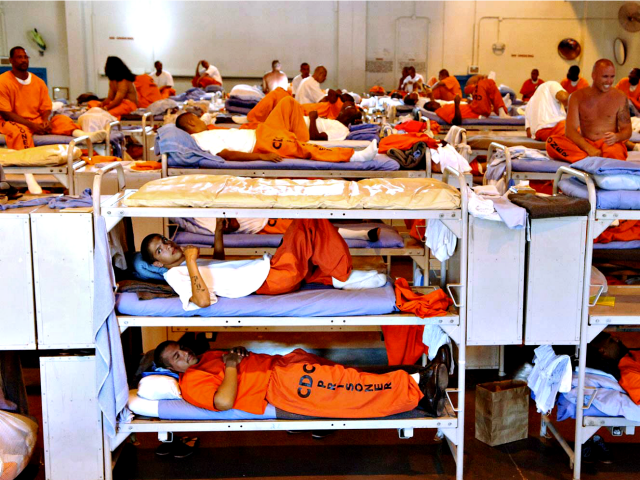Supporters of the criminal justice rewrite continue to urge Congress to vote on legislation that has languished in both the House and the Senate for months.
Just in the past several days, The Washington Post, together with lobbyists from the Bank of America and La Raza, held a “Criminal Justice Summit” at the newspaper’s headquarters in Washington, D.C., presenting a couple of hundred onlookers with several panels of advocates favoring reform and all of one opponent; and a national news organization ran an op-ed by a noted conservative and a noted liberal on why the bill must be passed immediately.
Unfortunately, both the Washington Post and our bipartisan team of editorialists made their points by ignoring the facts surrounding the legislation in favor of ideology.
Here are the facts.
First, decades ago, Congress passed legislation that imposed mandatory minimum sentences on criminals convicted of the most serious crimes in federal court. Many states followed.
The rationale behind mandatory minimums was and remains three-fold: to deter criminals from engaging in further criminal behavior, to ensure a meaningful period of time elapsed for rehabilitation, and to incapacitate the criminal from victimizing law-abiding citizens.
Not surprisingly, it worked. Violent crime went down by half nationwide. The FBI reports that the rate of violent crime—murder, rape, robbery and aggravated assault—per 100,000 people went from 758.2 in 1991 to 367 in 2013. Gains in the reduction of property crime were comparable: The property crime rate—including burglary, larceny and motor vehicle theft per 100,000—dropped from 5,140 in 1991 to 2,730 in 2013.
Lesson: Crime has gone down because the prison population went up.
Second, about two million criminals are presently incarcerated in the United States—a small fraction of which are in federal prison. Roughly 95 percent will eventually be released—some sooner, some later. Half of all federal prisoners are rearrested within eight years, and more than three-quarters of state prisoners are rearrested within five years. Even programs designed to reduce recidivism have turned out to have only a slight effect on employment and earnings, and virtually no impact on recidivism.
Further, a recent report by the Government Accountability Office concluded that the Department of Justice doesn’t even adequately track the results of some of these programs. While America is the land of second chances, the evidence shows that few serious criminals make the most of them.
Lesson: Most crime is committed by a small number of people, and most people don’t commit any crimes. Locking up one multi-offender is the best way to deter future crimes.
Third, so-called “low-level, non-violent” drug offenders are very hard to find in federal prison—period. Simple drug possessors make up less than one-third of one percent of the drug felons in federal prison, and most of those likely pled down from more serious charges. Federal mandatory minimums are used almost exclusively for high-level drug king-pins who have trafficked in large quantities of hard drugs.
Lesson: What works in the states, at least as far as criminal justice issues are concerned, does not necessarily work in the federal system.
Fourth, mandatory minimum sentences reduce the quantity of drugs on the street. According to the Centers for Disease Control and Prevention, approximately 130 people are dying every day in the United States of a drug overdose, and drug overdose deaths now far outpace deaths by motor vehicles and firearms. The first step to combatting this epidemic is to take—and keep—these death-peddlers off the streets. Illicit drugs are inexorably linked to violent crime, both because of the things addicts will do to obtain a “high” and the things drug traffickers will do to collect debts, expand their territory, and eliminate rivals to grow their deadly business.
Lesson: Fewer drug dealers on the street means fewer drugs on the street, and will inevitably result in fewer addicts, fewer overdose deaths, and fewer violent and property crimes.
Fifth, President Obama and his Justice Department have already done more than enough to put dangerous criminals back on the streets.
In August 2013, former Attorney General Holder ordered federal prosecutors to stop charging certain drug felons with mandatory minimums—regardless of the quantity of drugs involved. Today, there are 24 percent fewer federal drug trafficking prosecutions today than five years ago.
The Obama Administration also instructed federal prosecutors to forgo felon in possession of firearm prosecutions unless they are connected to an additional crime. As a result, the Obama Administration obtained only about 6,000 gun crime convictions in 2015—a more than 15 percent drop from just five years ago.
In addition, President Obama has surpassed the past ten presidents combined in total commutations of federal sentences. These individuals have included drug kingpins, gun-traffickers, and career criminals—not “low-level, non-violent” offenders, as White House spin doctors and liberal pundits would have us believe. In August alone, he commuted the sentences of 325 more felons, dozens of whom were sentenced to life imprisonment. In the midst of these commutations, the President issued new, bitterly ironic executive orders aimed at “reducing gun violence.”
Lesson: If the President is sincere about reducing drug abuse and gun violence, he should think twice about prematurely returning individuals with violent histories back into our communities.
The federal criminal justice system does need some reforms, not the least of which is a review of all criminal laws, eliminating many that do nothing to control crime and others which are obsolete.
Releasing more violent offenders, however, is not a reform that will help anybody; instead, it will do quite the opposite.

COMMENTS
Please let us know if you're having issues with commenting.